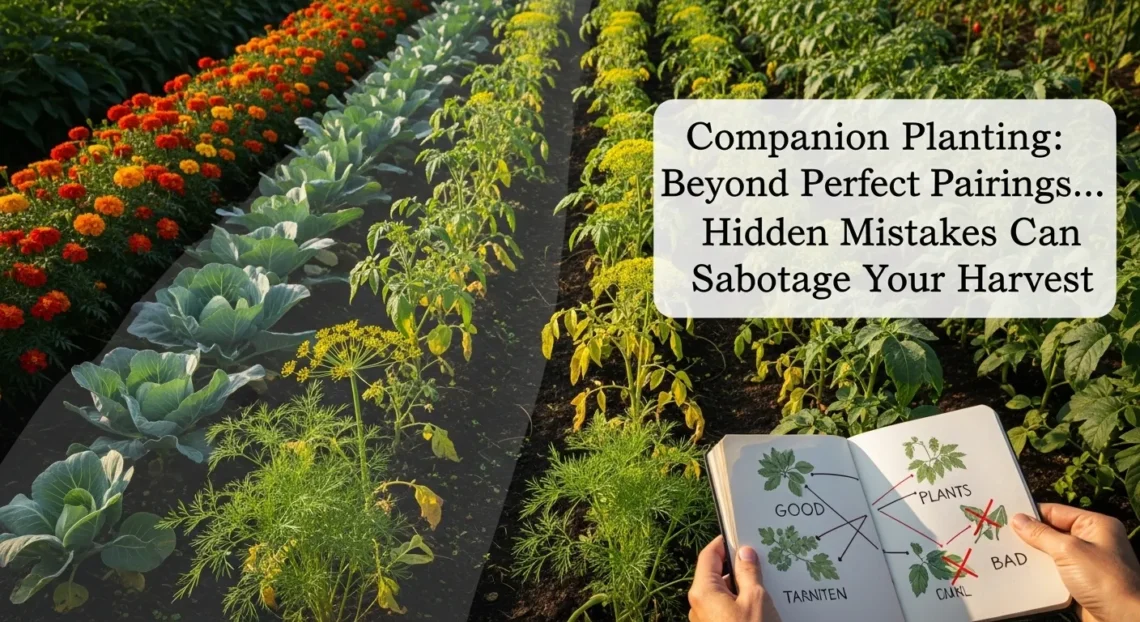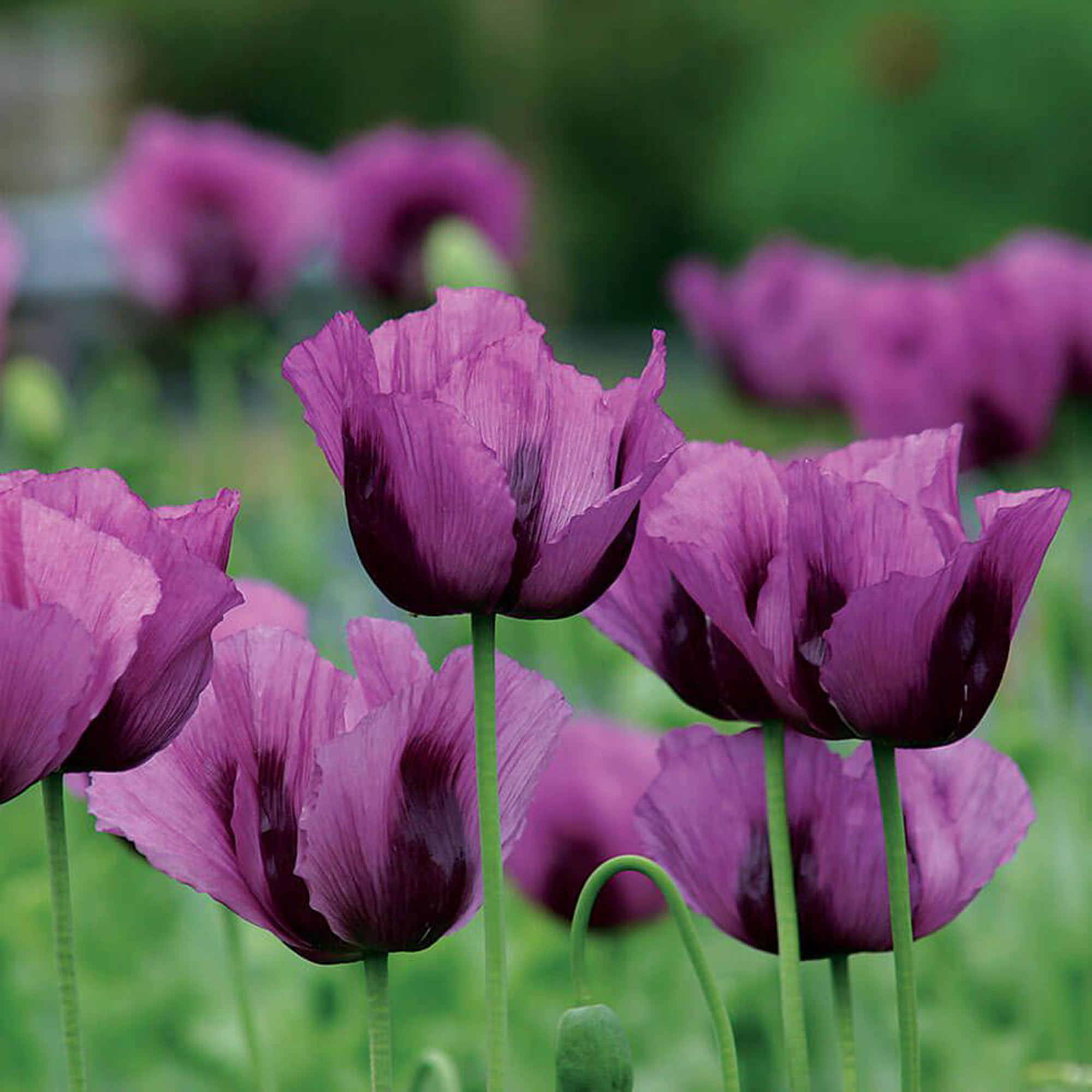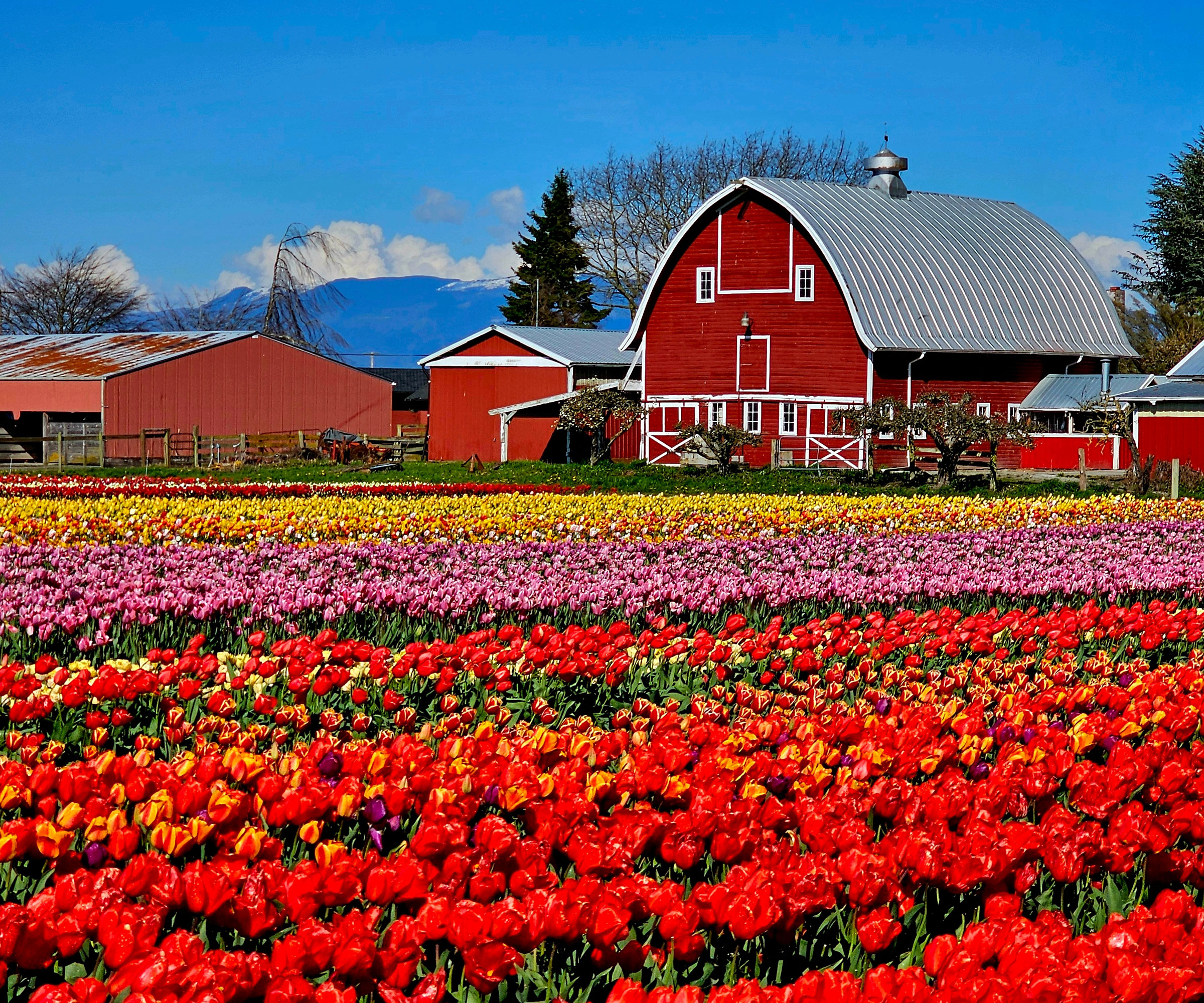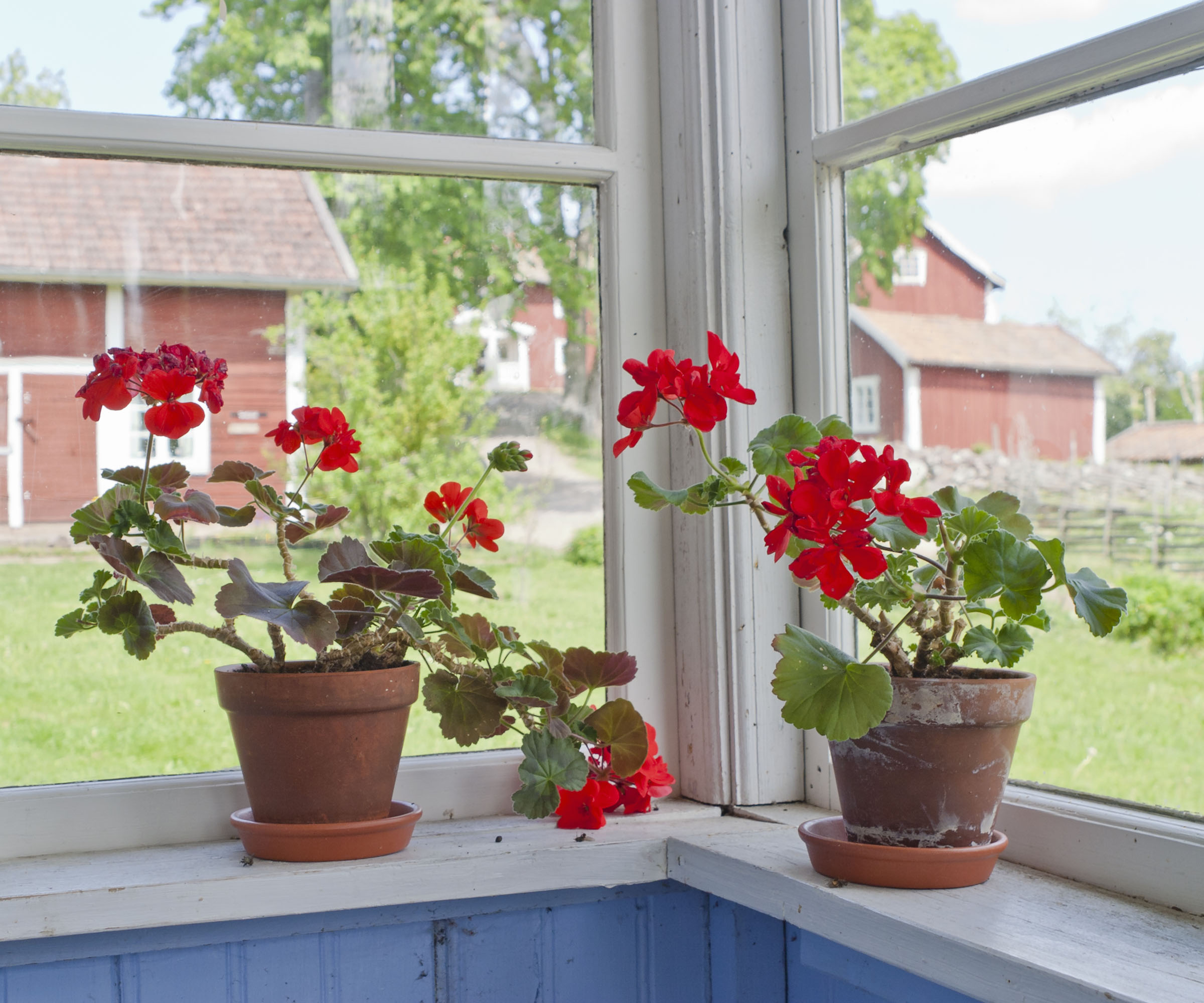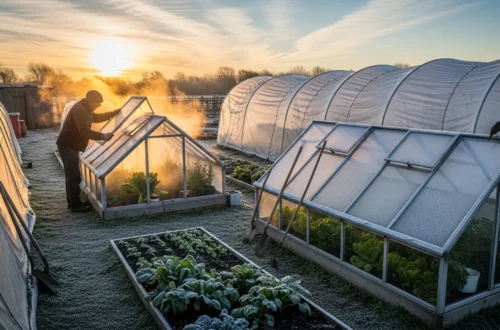Table of Contents
Table of Contents
Introduction
Most companion planting guides focus on the perfect pairings—tomatoes with basil, beans with corn, marigolds with just about everything. But here’s the truth: knowing what not to plant together is just as important as knowing the “good” combos.
Over the years, I’ve seen plenty of gardens fail not because of pests or poor soil, but because of simple companion planting mistakes. These errors are easy to make, especially for beginners, and they can quietly sabotage your harvest.
In this guide, we’ll uncover the bad companion plants and overlooked pitfalls that no one really talks about—plus the quick fixes that will keep your garden thriving.
Common Companion Planting Mistakes Gardeners Overlook
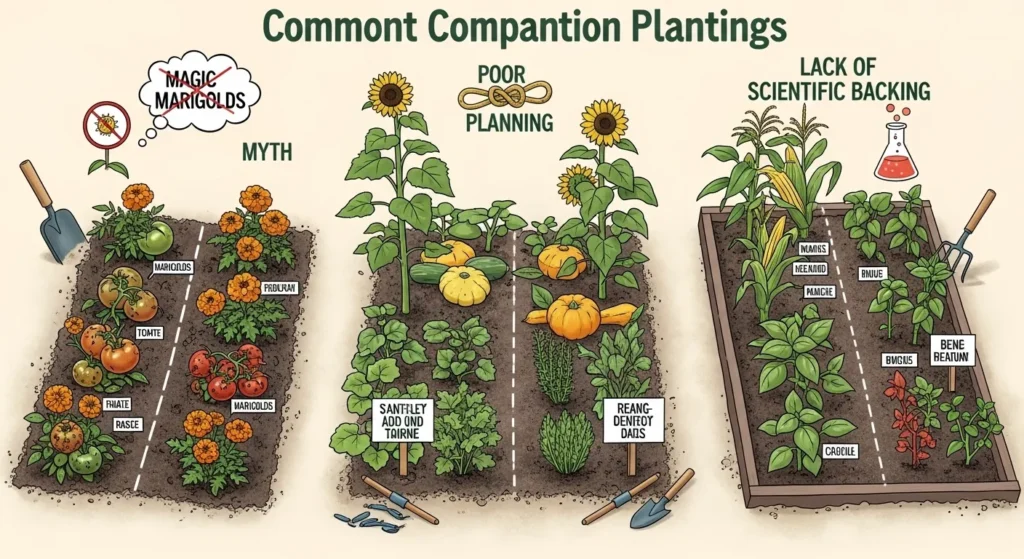
Companion planting is powerful, but it’s not foolproof. Many gardeners assume that if two plants are “friendly,” they can be grown side by side without issue. But the reality is more nuanced.
Some companion planting mistakes happen because of poor planning, while others come from following myths passed down without scientific backing. Let’s break down the most common errors that can turn a promising garden into a frustrating one.
What Not to Plant Together (The Hidden Traps)
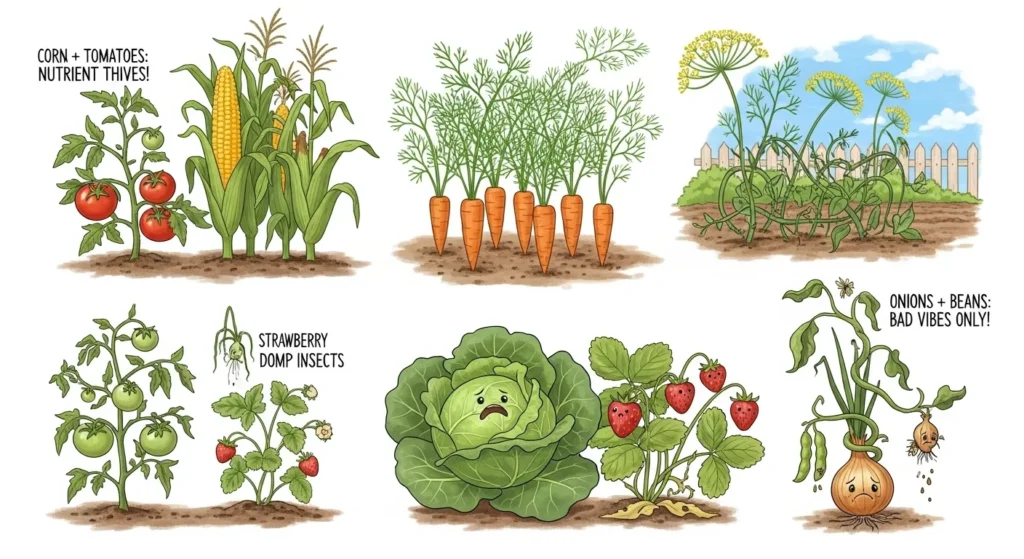
One of the biggest beginner slip-ups is pairing plants that simply don’t get along. These plants that don’t grow well together often compete for the same nutrients, attract the same pests, or create microclimates that stress each other out.
Classic bad pairings include:
- Tomatoes + Corn → Both are heavy feeders, draining nitrogen fast. This leads to weak plants and smaller harvests.
- Carrots + Dill → Dill attracts carrot rust flies, which devastate roots.
- Cabbage + Strawberries → Strawberries suffer when planted near brassicas due to soil competition.
- Beans + Onions → Onions release compounds that slow bean growth.
👉 Quick Fix: Before planting, check a companion planting chart and look for proven pairings. If you’re unsure, keep heavy feeders apart and mix in nitrogen-fixers like beans or peas. For a deeper dive into raised bed layouts, see my guide on Raised Bed Gardening Mistakes.
Bad Companion Plants That Compete for Nutrients
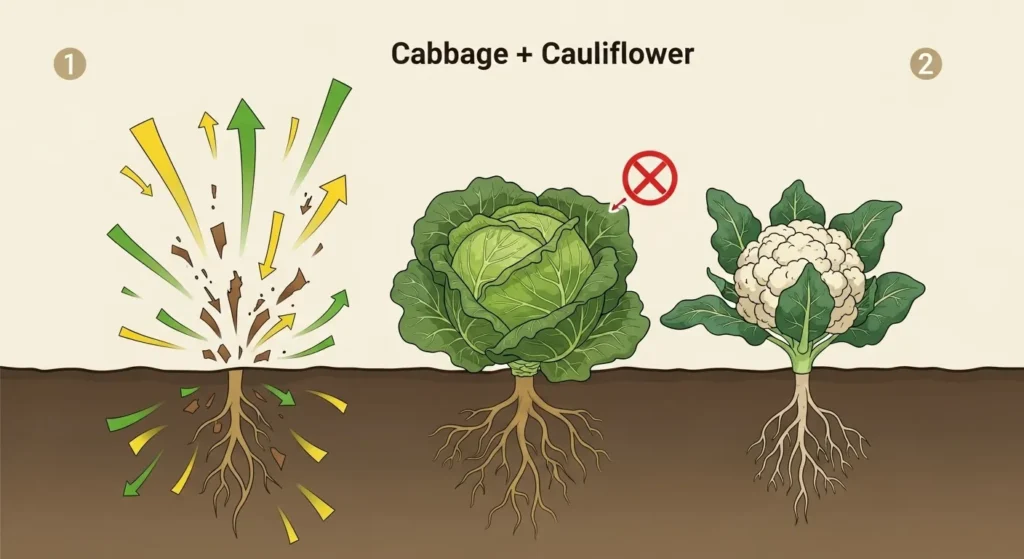
One of the sneakiest companion planting mistakes is pairing crops that are both “heavy feeders.” These bad companion plants drain the soil of the same nutrients, leaving both struggling.
Examples of nutrient competition:
- Corn + Tomatoes → Both demand huge amounts of nitrogen and potassium.
- Cabbage + Cauliflower → Brassicas planted together quickly exhaust the soil.
- Squash + Pumpkins → Both sprawl and compete for space and nutrients.
👉 Quick Fix: Mix in nitrogen-fixers like beans or peas between heavy feeders. Or rotate crops each season so the soil has time to recover. See the “University of Minnesota Extension – Crop Rotation Basics” for more details.
Another overlooked issue is planting companions without considering their growth rates. Fast-growing crops like radishes or lettuce can quickly crowd out slower growers such as carrots or parsnips if they’re not managed properly. This imbalance often leads to frustration when the slower crop never reaches its full potential. Many gardeners assume that because two plants are “compatible,” they’ll thrive together automatically—but mismatched growth speeds are one of the most subtle companion planting mistakes that can quietly sabotage your harvest.
A second mistake is ignoring the long-term lifecycle of companion plants. Some crops, like dill or fennel, start out as helpful companions but later release chemicals or grow aggressively, turning into poor neighbors. Gardeners who don’t plan for these changes often find themselves dealing with stunted growth or unexpected pest problems mid-season. This highlights why companion planting isn’t just about choosing the right partners—it’s also about timing, succession planting, and knowing when to separate crops before they become bad companion plants.
Plants That Don’t Grow Well Together (And Why)
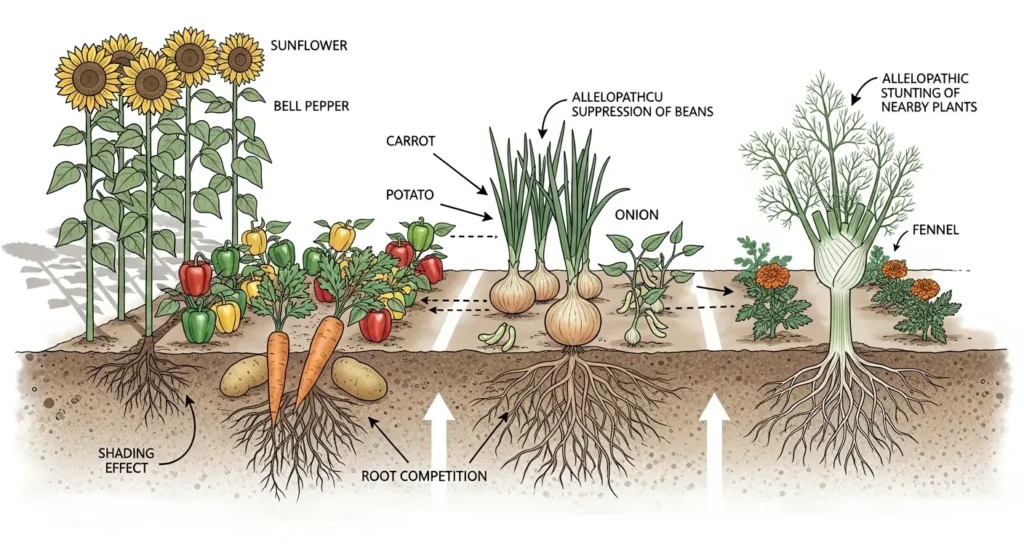
Not every plant is a good neighbor. Some plants don’t grow well together because of root depth, shade, or even chemical signals they release into the soil.
Examples:
- Sunflowers + Peppers → Tall sunflowers cast too much shade, stunting peppers.
- Carrots + Potatoes → Both root crops compete underground, leading to smaller harvests.
- Onions + Beans → Onions release compounds that slow bean growth.
- Fennel + Almost Anything → Fennel secretes allelopathic chemicals that inhibit the growth of nearby plants.
👉 Quick Fix: Pair shallow-rooted crops (like lettuce) with deep-rooted ones (like carrots). And always plan your garden layout with sun exposure in mind.
Companion Planting Gone Wrong: Real-Life Examples
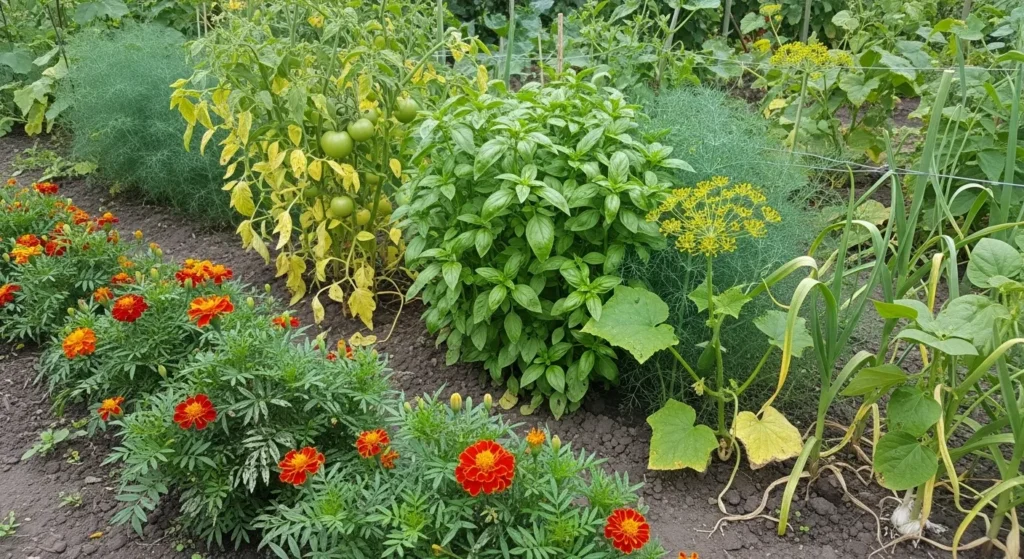
Sometimes, even well-meaning gardeners fall for myths. This is where companion planting gone wrong stories come in handy—they show what not to do.
Common myths and failures:
- The Marigold Myth → Many believe marigolds repel all pests. In reality, they only deter certain nematodes and aphids. Planting them everywhere won’t save your garden.
- The Basil Overload → Basil is great with tomatoes, but overcrowding them creates airflow problems, leading to fungal diseases.
- The Dill Disaster → Dill helps cucumbers early on, but once it matures, it stunts their growth.
- The Garlic Misstep → Garlic repels some pests, but when planted too close to beans, it suppresses their growth.
Another example of companion planting gone wrong is when gardeners assume that every aromatic herb is universally beneficial. While herbs like rosemary and thyme can deter certain pests, planting them too close to delicate crops like lettuce or spinach can overwhelm their growth with strong essential oils released into the soil. This is a subtle companion planting mistake that doesn’t show up immediately but reduces yields over time.
A second overlooked issue is trusting generalized advice without considering local climate or soil conditions. For instance, planting beans with corn is often recommended, but in regions with poor soil fertility or limited rainfall, both crops may struggle together instead of thriving. This shows that even “classic” combinations can fail if the environment isn’t right. Many gardeners learn this the hard way, turning a trusted method into a case of companion planting gone wrong.
Finally, mismanaging spacing between companion plants can undo all the benefits. For example, cucumbers and radishes can work well together, but if planted too close, cucumbers sprawl and shade out the radishes before they mature. This is one of those companion planting mistakes that frustrates beginners because they followed the advice but overlooked the spacing details.
👉 Quick Fix: Don’t rely on “old wives’ tales.” Check proven pairings and adjust based on your local climate and soil. Learn more from the “Royal Horticultural Society – Companion Planting“.
Raised Bed Companion Planting Mistakes to Avoid
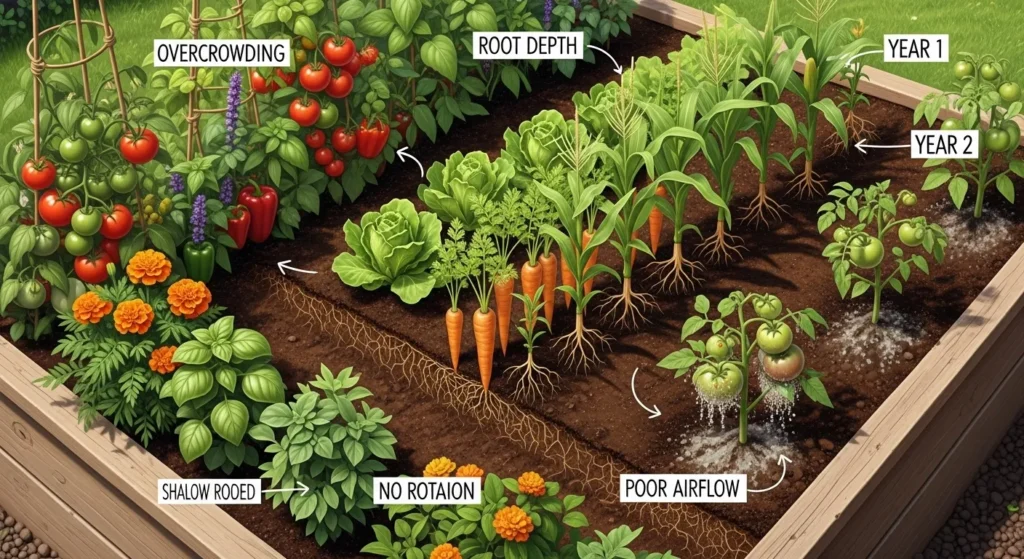
Raised beds are fantastic for control and productivity, but they also magnify errors. Small spaces mean mistakes spread faster. Here are the most common raised bed companion planting mistakes:
- Overcrowding “friendly” plants → Tomatoes and basil are great partners, but cramming them too close in a raised bed reduces airflow and invites fungal disease.
- Ignoring root depth → Mixing deep-rooted crops (like carrots) with shallow-rooted ones (like lettuce) works well, but planting two deep-rooted crops together leads to stunted growth.
- Not rotating crops → In a confined raised bed, planting the same companions year after year depletes soil nutrients quickly.
- Poor spacing for airflow → Raised beds often tempt gardeners to “pack it in.” But poor airflow leads to mildew and blight.
👉 Quick Fix: Plan raised bed layouts with spacing in mind, rotate crops annually, and mix root depths for balance. For a clever twist, check out my “Soil-Free Tomato Growing Hack.
Another common mistake is when gardeners ignore the spread of plant roots in raised beds. Because the space is limited, both depth and width matter. If you plant two crops with roots that grow at the same level, they’ll quickly compete for nutrients and water. This hidden companion planting mistake often leads to stunted growth and disappointing harvests, even when the plants are technically “good companions.”
Similarly, overlooking water flow and drainage in raised beds can cause major problems. Some plants thrive in consistently moist soil, while others prefer drier conditions. If you place them side by side in the same bed, one will flourish while the other struggles. Many beginners assume raised beds automatically solve watering issues, but in reality, poor drainage or uneven watering can magnify these companion planting mistakes.
Finally, forgetting about pollination needs in raised beds is another pitfall. If you fill most of the space with leafy greens and neglect to include flowering plants that attract pollinators, your fruiting crops—like tomatoes, cucumbers, or squash—may not set fruit properly. This is a subtle but costly companion planting mistake that directly reduces yield. Adding pollinator-friendly flowers or herbs to your raised bed design can make a huge difference in productivity.
Common Gardening Mistakes Beginners Make
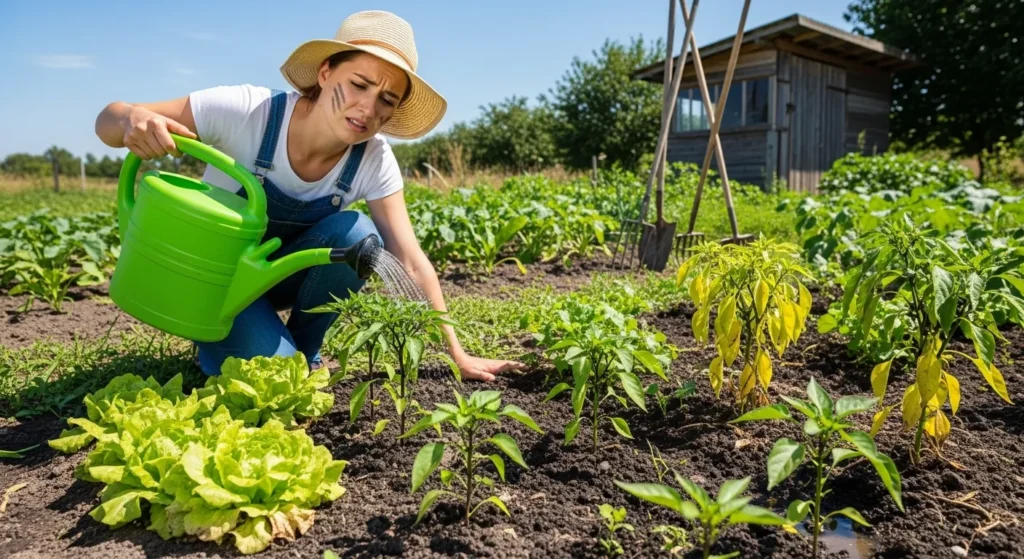
Even outside of companion planting, there are common gardening mistakes beginners make that can ruin a season’s work:
- Planting too early or too late → Seasonal timing matters; lettuce bolts in heat, while peppers sulk in cold soil.
- Watering inconsistently → Overwatering leads to root rot, while underwatering stresses plants and reduces yield.
- Believing every “hack” online → Not all gardening tips are universal; what works in one climate may fail in another.
- Ignoring soil health → Companion planting works best in fertile soil. Neglecting compost or organic matter undermines the whole system.
Another frequent issue is planting without considering companion plant spacing. Beginners often assume that if two crops are compatible, they can be planted right next to each other. But even good companions need breathing room. Tomatoes and basil, for example, thrive together, but if they’re crammed too tightly, airflow is restricted and fungal diseases spread quickly. This is one of those subtle companion planting mistakes that can undo all your hard work.
A second overlooked mistake is ignoring succession planting. Many new gardeners plant everything at once, which leads to a glut of produce followed by long gaps with nothing to harvest. Companion planting works best when you stagger crops—like sowing lettuce every two weeks alongside slower growers such as carrots. Without this planning, beds sit empty or overcrowded, and the benefits of companion planting are lost.
Finally, beginners often forget to observe their garden regularly. Companion planting isn’t a “set it and forget it” system. Pests, diseases, and nutrient deficiencies can creep in quickly. By checking plants every few days, you’ll notice early signs of stress—yellowing leaves, stunted growth, or insect damage—and can adjust before the problem spreads. Neglecting this simple habit is one of the most common companion planting mistakes that separates thriving gardens from struggling ones.
👉 Quick Fix: Start small, track planting dates, and adjust based on your local climate. Use the “USDA Plant Hardiness Zone Map” to guide your planting schedule.
Quick Reference Table – Companion Planting Mistakes & Fixes
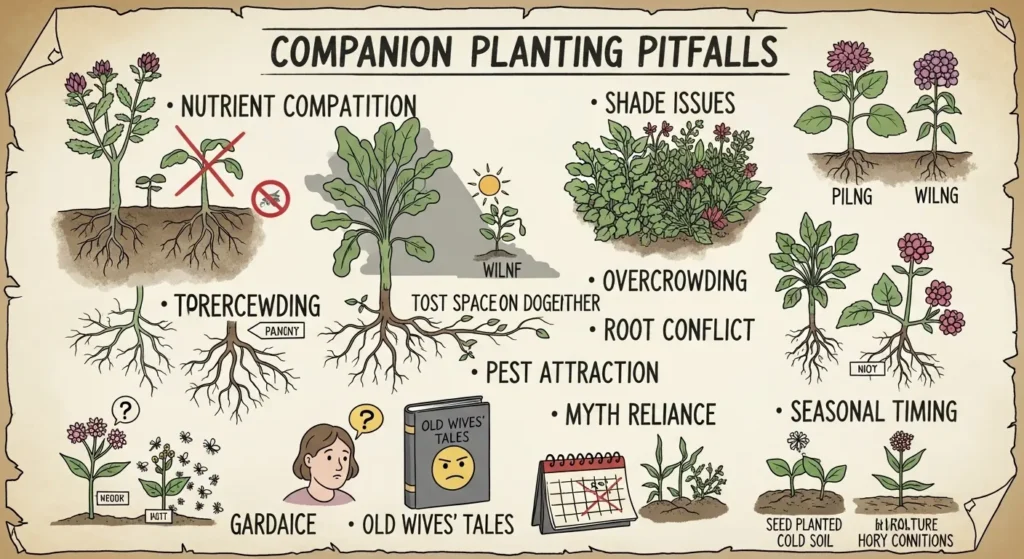
| Research-proven pairings | Example | Fix |
|---|---|---|
| Nutrient competition | Corn + Tomatoes | Add beans or rotate crops |
| Shade issues | Sunflowers + Peppers | Plan layout for sun exposure |
| Overcrowding | Basil + Tomatoes | Maintain spacing |
| Root conflict | Carrots + Potatoes | Mix shallow + deep-rooted crops |
| Pest attraction | Dill + Carrots | Plant apart or use trap crops |
| Myth reliance | Marigolds repel all pests | Research proven pairings |
| Seasonal timing | Lettuce + Eggplant | Stagger planting times |
Conclusion

Companion planting is powerful, but only if you avoid the hidden pitfalls. By steering clear of bad companion plants, watching out for plants that don’t grow well together, and learning from companion planting gone wrong stories, you’ll set yourself up for healthier harvests.
Remember: gardening is as much about avoiding mistakes as it is about following best practices. Start small, experiment, and keep notes—you’ll quickly learn what works best in your own garden.
Companion planting is often celebrated as a gardener’s secret weapon, but the truth is that it only works when done thoughtfully. The biggest harvest losses don’t usually come from pests or poor soil—they come from overlooked companion planting mistakes. Whether it’s pairing heavy feeders side by side, ignoring root depth, or falling for old myths, these small errors can quietly undermine months of effort. By learning to spot and avoid them, you’re already ahead of most beginner gardeners.
It’s also important to remember that companion planting is not a one‑size‑fits‑all formula. What works in one climate or soil type may not work in another. That’s why observing your garden, keeping notes, and adjusting year after year is so powerful. Avoiding companion planting mistakes isn’t about memorizing endless lists—it’s about understanding the principles of plant relationships and applying them to your unique space.
Think of your garden as a living community. Just like people, plants thrive when they’re surrounded by the right neighbors and given enough space to grow. By steering clear of bad companion plants, planning for pollination, and respecting each crop’s needs, you’ll create a balanced ecosystem that rewards you with healthier harvests and fewer problems.
Finally, don’t be discouraged if you’ve made some of these companion planting mistakes before—every gardener has. Mistakes are part of the learning process, and each season gives you a chance to refine your approach. Start small, experiment with combinations, and celebrate the wins along the way. Over time, you’ll develop an instinct for what works best in your garden.
👉 Ready to take the next step? Explore my guide on Low‑Maintenance Gardening Hacks to make your garden even easier to manage, or check out Soil‑Free Tomato Growing for a clever method that pairs perfectly with companion planting strategies.
Faq On Companion Planting Mistakes
Can you plant cucumbers next to tomatoes?
Yes, but give them space and trellising. Both are heavy feeders and can compete for nutrients and airflow. Keep at least 18–24 inches between vines, train cucumbers vertically, and interplant basil or nasturtiums nearby for pest management without crowding.
What are the worst companion planting mistakes to avoid?
u003cstrongu003eHeavy feeders together:u003c/strongu003e Corn + tomatoes or cabbage + cauliflower exhaust soil.u003cbru003eu003cstrongu003eAllelopathic neighbors:u003c/strongu003e Fennel inhibits many plants.u003cbru003eu003cstrongu003eShade conflicts:u003c/strongu003e Sunflowers can stunt peppers.u003cbru003eu003cstrongu003ePest pairing:u003c/strongu003e Dill near carrots attracts carrot rust fly. Plan spacing, sun, and crop rotation to prevent these issues.
Do beans and onions grow well together?
No. Alliums (onions, garlic) can suppress bean growth. Keep them in separate beds or at least a few feet apart, and pair beans with corn or squash instead for better synergy.
Is the marigold trick a myth?
Partly. Marigolds can help with specific pests (like certain nematodes and aphids), but they don’t repel everything. Use them as part of a broader strategy—good spacing, healthy soil, and diverse plantings—rather than a single fix.
Should dill be planted with carrots?
Avoid it. Dill can attract carrot rust fly and, once mature, compete for resources. If you want dill, place it away from carrot beds or time it after your carrot harvest.
How far apart should companion plants be in raised beds?
Maintain airflow: 18–24 inches for tomatoes, 12–18 inches for peppers, and at least 6–8 inches for basil or leafy greens. In small beds, stagger plants, mix root depths (deep-rooted carrots with shallow lettuce), and leave pathways for pruning and harvest.
How often should I rotate crops to prevent problems?
Rotate annually. Avoid planting the same family in the same spot two years in a row (e.g., brassicas, nightshades). Integrate legumes (beans/peas) after heavy feeders to help replenish nitrogen.
What are the signs my companion planting is going wrong?
– Stunted growth or yellowing leaves despite watering.u003cbru003e- Excess shade or poor airflow causes mildew.u003cbru003e- Pest spikes associated with certain pairings (e.g., carrot rust fly near dill).u003cbru003e- Flowering crops failing to set fruit (pollination gaps). Adjust spacing, neighbors, u003cbru003e and add pollinator flowers to recover.
Can herbs ever harm neighboring vegetables?
Yes. Some strong, woody herbs (like rosemary or fennel) can compete or inhibit growth. Keep them at the bed edges or in separate containers, and use milder companions (basil, parsley, cilantro) near tender greens or tomatoes.
What’s a quick way to fix overcrowded companions mid‑season?
Thin aggressively, prune for airflow, and move container herbs out of congested spots. Add a top‑dressing of compost, then deep‑water and mulch to reduce stress. If shade is the issue, trellis vines vertically to reclaim light.

